Table of Contents
Jollof rice and chicken is more than just a dish; it’s a cultural symbol across West Africa, representing unity, celebration, and pride. From Nigeria to Ghana, Senegal to Sierra Leone, each country has its own version of jollof rice, sparking friendly debates over which version is best. This ultimate guide will provide you with everything you need to create your own jollof rice and chicken masterpiece, ensuring that your dish is not only delicious but also true to its rich heritage.
What is Jollof Rice and Chicken?

Jollof rice and chicken is a dish that resonates deeply with West Africans, both at home and abroad. The dish is rooted in the culinary traditions of the Wolof people, who originally hailed from the Senegambian region. The word “jollof” is derived from the Wolof word “benachin,” which means “one pot.” This cooking method, where rice, vegetables, and protein are all cooked together, has transcended borders, becoming a staple in the cuisines of countries like Nigeria, Ghana, Sierra Leone, and Liberia.
In its simplest form, jollof rice is made with rice, tomatoes, onions, and a variety of spices. However, the variations are endless. Some prefer to cook the rice separately and mix it with the sauce later, while others swear by the one-pot method. Chicken, as a protein, complements the dish perfectly, adding a savory depth that enhances the overall flavor.
Goat meat Pepper soup With Plantain recipe Best of 2024
The History of Jollof Rice and Chicken
Understanding the history of jollof rice and chicken is crucial to appreciating its cultural significance. The dish originated from the Wolof Empire, which was one of the most powerful states in West Africa during the 14th and 15th centuries. The Wolof people were known for their agricultural prowess, cultivating rice, millet, and sorghum. Over time, the recipe for jollof rice spread throughout the region, adapting to local tastes and ingredients.
In Senegal, the dish is known as “thieboudienne,” traditionally made with fish and vegetables. As the dish traveled, it evolved, with each country adding its own unique twist. In Nigeria, for example, jollof rice is often cooked with a smoky flavor, achieved by allowing the rice to caramelize slightly at the bottom of the pot. In Ghana, the rice is typically cooked with a blend of spices that includes nutmeg, cloves, and bay leaves.
The introduction of tomatoes, a key ingredient in jollof rice, is linked to European colonization. Portuguese traders brought tomatoes to West Africa in the 16th century, and the fruit quickly became a staple in local cooking. Today, tomatoes are an essential component of jollof rice, giving the dish its vibrant red color and rich flavor.
Goat Meat Pepper Soup with Scent Leaves : Best of 2024
Ingredients You Need for Jollof Rice and Chicken
To make jollof rice and chicken, you need to start with high-quality ingredients. The success of this dish depends on the freshness and quality of the components. Let’s dive deeper into each ingredient and understand why it’s important.
- Rice: The type of rice you choose can make or break your jollof rice. Long-grain parboiled rice is the most popular choice because it absorbs flavors well without becoming mushy. Parboiling partially cooks the rice, making it firmer and less likely to stick together. In some regions, basmati rice is used for its aromatic qualities, though it tends to be less traditional.
- Chicken: For the chicken, bone-in pieces like thighs and drumsticks are preferred because they remain juicy and flavorful during cooking. The chicken can be marinated in a variety of spices to enhance its flavor before cooking. In some versions of jollof rice, the chicken is grilled or roasted after marinating to add a smoky flavor to the dish.
- Tomatoes: Tomatoes are the backbone of jollof rice, providing acidity and sweetness. Fresh, ripe tomatoes are ideal, but canned tomatoes or tomato paste can be used when fresh tomatoes are out of season. The key is to cook the tomatoes until they lose their raw taste and deepen in flavor.
- Onions: Onions add a sweet, aromatic quality to the dish. Red onions are commonly used, but yellow or white onions can also work. Sautéing the onions until they’re golden brown enhances their sweetness and helps build the flavor base for the dish.
- Bell Peppers: Red bell peppers are preferred for their sweetness and vibrant color. They blend seamlessly into the tomato base, adding another layer of flavor. Some variations of jollof rice include green bell peppers, which add a slightly bitter contrast to the sweetness of the red peppers.
- Scotch Bonnet Peppers: Scotch bonnet peppers are small but mighty, packing a lot of heat. They are a staple in West African cooking and give jollof rice its signature spicy kick. If you’re sensitive to heat, you can remove the seeds or use a milder chili pepper.
- Garlic and Ginger: Garlic and ginger are aromatics that add depth and complexity to the dish. Freshly minced garlic and ginger are ideal, but you can also use garlic and ginger paste for convenience.
- Bay Leaves: Bay leaves are often overlooked, but they add a subtle, earthy flavor that balances the acidity of the tomatoes. Adding a few bay leaves to the pot as the rice cooks can elevate the overall taste of the dish.
- Thyme: Thyme is another essential herb that adds an earthy, slightly minty flavor. Fresh thyme is best, but dried thyme can also be used. Some variations of jollof rice include other herbs like parsley or cilantro, which add freshness and color.
- Curry Powder and Paprika: Curry powder and paprika add warmth and color to the dish. Curry powder is a blend of spices like turmeric, cumin, and coriander, which add complexity to the flavor profile. Paprika, made from ground red peppers, adds a smoky, sweet flavor that complements the tomatoes.
- Chicken Stock: Chicken stock adds depth of flavor and richness to the rice. If you have time, making your own chicken stock is worth the effort. Homemade stock is more flavorful and can be customized with herbs and spices to suit your taste. However, store-bought stock can also work in a pinch.
- Vegetable Oil: Vegetable oil is used for sautéing the onions and browning the chicken. It’s important to use a neutral oil that doesn’t overpower the other flavors in the dish. Some variations of jollof rice use palm oil, which adds a distinctive flavor and color to the dish.
- Salt and Pepper: Seasoning with salt and pepper is essential for balancing the flavors in the dish. Salt enhances the natural flavors of the ingredients, while pepper adds a hint of heat.
Preparing the Chicken(Jollof Rice and Chicken)
The chicken in jollof rice is often marinated to infuse it with flavor before cooking. Marinating the chicken not only enhances its taste but also helps to tenderize it. Depending on the flavor profile you prefer, you can marinate the chicken with a combination of salt, pepper, garlic, ginger, thyme, curry powder, and paprika. Adding a squeeze of lemon or lime juice can also help to tenderize the meat and add a zesty flavor.
When it comes to marinating, time is your best friend. Allowing the chicken to marinate for at least 30 minutes helps the flavors penetrate the meat. For even better results, marinate the chicken overnight in the refrigerator. This will give you tender, flavorful chicken that pairs perfectly with the jollof rice.
Once your chicken is marinated, it’s time to brown it. Browning the chicken adds a depth of flavor that cannot be achieved by simply cooking it in the sauce. Heat a large pot or Dutch oven over medium-high heat and add a few tablespoons of vegetable oil. Once the oil is hot, add the chicken pieces, making sure not to overcrowd the pot. Brown the chicken on all sides until it’s golden and crispy. This step is crucial as it locks in the juices and adds a rich, savory flavor to the dish.
After browning the chicken, remove it from the pot and set it aside. You’ll be adding it back to the pot later to finish cooking. The browned bits left in the pot are full of flavor and will enhance the tomato sauce and rice when you start cooking the jollof rice base.
Making the Jollof Rice Base for Jollof Rice and Chicken
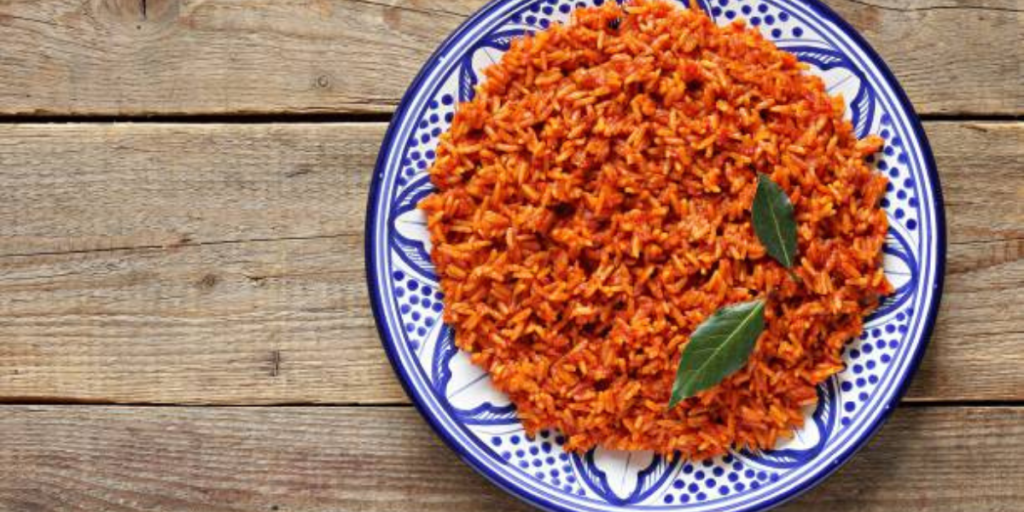
The base of jollof rice is a rich tomato sauce that forms the foundation of the dish’s flavor. This step is crucial, as the depth of flavor in the sauce will directly impact the taste of the final dish. Here’s a more detailed breakdown of how to create the perfect jollof rice base:
- Sautéing the Onions: In the same pot where you browned the chicken, add more oil if needed and reduce the heat to medium. Add finely chopped onions and sauté until they’re soft and translucent. This step is essential as it builds the flavor foundation for the sauce. The onions should be golden but not burnt, as burnt onions can add a bitter taste to the dish.
- Adding Garlic and Ginger: Once the onions are soft, add minced garlic and ginger. These aromatics will add depth and complexity to the sauce. Cook for another 2-3 minutes until fragrant, being careful not to burn them.
- Tomato Paste: Adding tomato paste at this stage intensifies the tomato flavor and adds richness to the sauce. Cook the tomato paste for 5-7 minutes, stirring frequently. This step helps to caramelize the sugars in the tomato paste, adding a slight sweetness that balances the acidity of the tomatoes.
- Fresh Tomatoes and Bell Peppers: Blend fresh tomatoes and red bell peppers into a smooth puree. Adding bell peppers to the tomato base enhances the sweetness and adds a vibrant red color. Pour the tomato and pepper mixture into the pot and stir well to combine. Allow the sauce to cook for about 20-30 minutes, stirring occasionally to prevent it from sticking to the bottom of the pot.
- Seasoning the Sauce: Season the sauce with curry powder, paprika, thyme, and bay leaves. These spices add warmth and depth to the sauce, transforming it into the signature jollof flavor. Don’t forget to season with salt and pepper as well. The sauce should be well-seasoned, as it will flavor the rice during cooking.
- Cooking Down the Sauce: Patience is key at this stage. The sauce needs time to cook down and develop its flavors. As the sauce simmers, the tomatoes will lose their raw taste, and the oil will start to separate from the sauce. This is a sign that the sauce is ready for the rice.
Cooking the Rice for Jollof Rice and Chicken
Cooking the rice perfectly is one of the most challenging aspects of making jollof rice. The rice needs to absorb the flavors of the sauce while remaining tender and fluffy. Here’s how to ensure your rice turns out perfect every time:
- Rinsing the Rice: Before adding the rice to the pot, it’s essential to rinse it thoroughly under cold water. Rinsing removes excess starch from the rice, preventing it from becoming too sticky. The water should run clear after rinsing, indicating that the starch has been removed.
- Toasting the Rice: Add the rinsed rice to the pot with the tomato sauce, stirring to coat each grain with the sauce. Toasting the rice in the sauce for a few minutes before adding the liquid helps to enhance its flavor and ensures that the rice absorbs the sauce evenly.
- Adding Chicken Stock: Once the rice is well-coated with the sauce, add the chicken stock. The stock adds flavor and moisture, allowing the rice to cook properly. The amount of liquid you add will depend on the type of rice you’re using and your desired texture. A general rule of thumb is to use about 2 cups of liquid for every cup of rice.
- Covering and Cooking: Cover the pot with a tight-fitting lid and reduce the heat to low. This step is crucial, as jollof rice needs to cook slowly to absorb the flavors without burning. Resist the urge to open the lid frequently, as this can release steam and affect the cooking process.
- Checking for Doneness: After about 20 minutes, check the rice for doneness. If the rice is still firm, add a bit more stock or water and continue cooking. The rice should be tender but not mushy, with each grain separate.
- Steaming the Rice: Once the rice is fully cooked, you can steam it for an additional 10 minutes. To do this, turn off the heat and leave the pot covered. The residual heat will steam the rice, making it fluffy and light.
Combining the Chicken and Rice for a tasty Jollof Rice and Chicken
Now that the rice is cooked and the chicken is browned, it’s time to bring everything together. Here’s how to do it:
- Layering the Chicken: Place the browned chicken pieces on top of the rice, making sure they’re evenly distributed. The chicken will continue to cook in the residual heat, allowing the flavors to meld together.
- Finishing the Cooking: Cover the pot again and let everything cook together for another 10-15 minutes. This step allows the chicken to finish cooking and infuses the rice with even more flavor. The juices from the chicken will seep into the rice, creating a delicious, savory dish.
- Resting the Dish: After the final cooking stage, let the jollof rice and chicken rest for a few minutes before serving. This allows the flavors to meld together and the rice to firm up slightly.
Serving Suggestions for Jollof Rice and Chicken
Jollof rice and chicken is a versatile dish that can be served on its own or with a variety of sides. Here are some popular serving suggestions that can elevate your meal:
- Fried Plantains: Fried plantains, known as “dodo” in Nigeria, are a popular side dish that pairs perfectly with jollof rice. The sweetness of the plantains complements the savory rice and chicken, creating a well-balanced meal. To make fried plantains, simply slice ripe plantains and fry them in hot oil until they’re golden brown and crispy.
- Steamed Vegetables: Lightly steamed vegetables like carrots, peas, and green beans add a healthy balance to the meal. The freshness of the vegetables provides a contrast to the rich, tomato-based jollof rice.
- Salad: A simple salad with fresh greens, tomatoes, cucumbers, and a light vinaigrette can add a refreshing element to the dish. The acidity of the vinaigrette cuts through the richness of the jollof rice, making for a well-rounded meal.
- Coleslaw: Creamy coleslaw adds a crunchy texture and cooling element to the dish. The combination of cabbage, carrots, and a tangy dressing complements the bold flavors of the jollof rice.
- Fried Fish: In some regions, jollof rice is served with fried fish instead of chicken. The crispy, golden fish adds a different texture and flavor profile to the dish.
- Boiled Eggs: In Ghana, jollof rice is often served with boiled eggs. The eggs add a creamy texture and protein boost to the dish, making it even more satisfying.
Tips for the Perfect Jollof Rice and Chicken
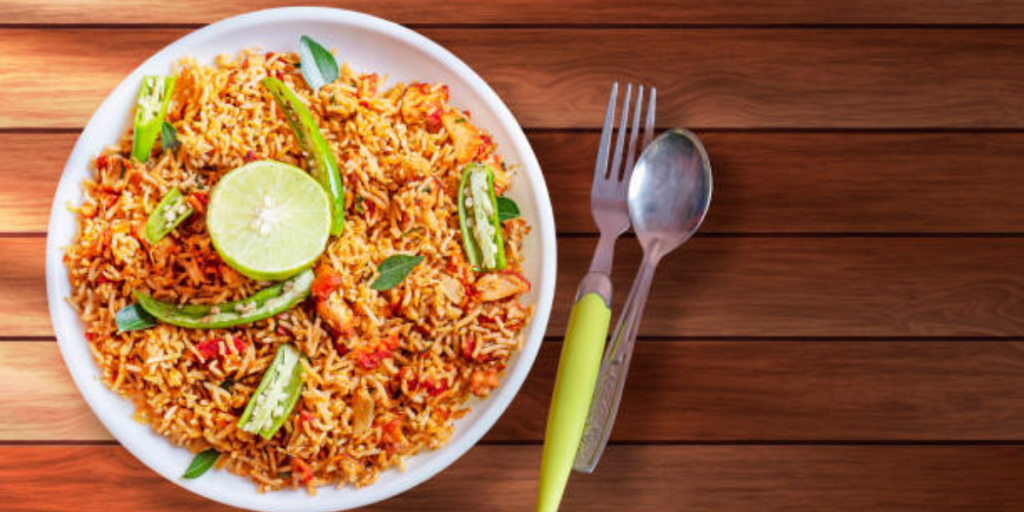
Making jollof rice and chicken can be tricky, but with the right tips, you’ll be able to create a dish that’s both delicious and authentic. Here are some expert tips to help you along the way:
- Use the Right Rice: The type of rice you use is crucial to the success of your jollof rice. Long-grain parboiled rice is the best choice because it absorbs the flavors of the sauce without becoming too soft or sticky. If you’re using another type of rice, such as basmati, be sure to adjust the cooking time and liquid accordingly.
- Control the Heat: Cooking jollof rice requires patience and careful temperature control. The dish should be cooked over low heat to prevent burning and ensure even cooking. If the heat is too high, the rice may burn at the bottom of the pot, giving the dish an unpleasant taste.
- Don’t Rush the Sauce: The tomato sauce is the heart of the dish, so take your time to cook it down properly. Cooking the sauce until the oil separates from the tomatoes ensures that the flavors are well-developed and the acidity is balanced.
- Season Generously: Jollof rice is meant to be bold and flavorful, so don’t be afraid to season generously. Taste the sauce as you go and adjust the seasoning as needed. The rice will absorb the flavors of the sauce, so it’s important to season the sauce well.
- Let it Rest: After cooking, let the jollof rice sit for a few minutes before serving. This allows the flavors to meld together and the rice to firm up slightly. It also makes the dish easier to serve, as the rice will be less likely to stick together.
Common Mistakes to Avoid
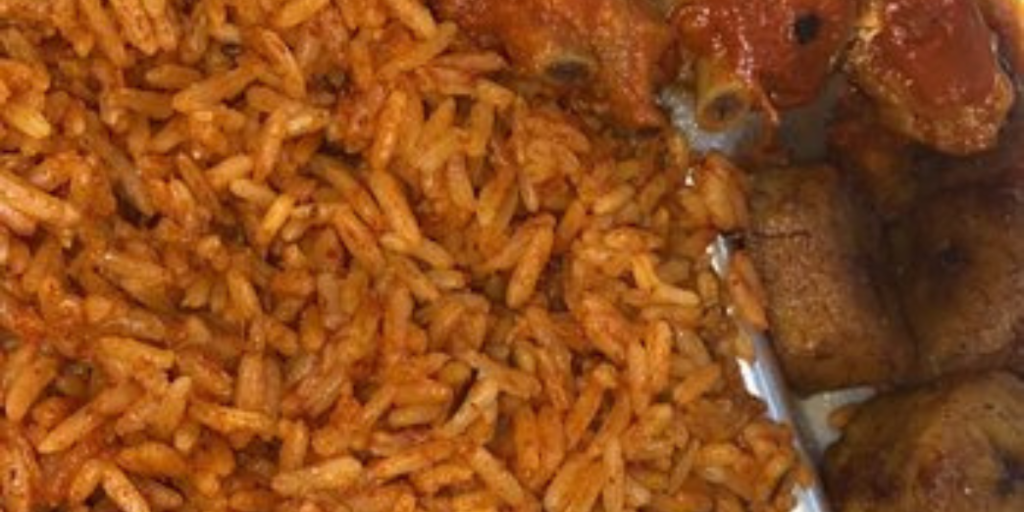
Even experienced cooks can make mistakes when making jollof rice and chicken. Here are some common pitfalls to avoid:
- Using the Wrong Rice: Using short-grain or sticky rice can result in a mushy dish. Stick to long-grain parboiled rice for the best results. If you’re unsure about the type of rice you’re using, cook a small test batch before adding it to the sauce.
- Skipping the Browning Step: Browning the chicken adds depth of flavor to the dish. If you skip this step, you may end up with bland chicken that doesn’t complement the rice. Take the time to brown the chicken properly before adding it to the dish.
- Rushing the Cooking Process: Jollof rice requires patience and careful attention to detail. Rushing the cooking process can result in unevenly cooked rice or burnt rice at the bottom of the pot. Take your time and cook the dish slowly over low heat.
- Not Using Enough Liquid: The rice needs enough liquid to cook properly, so make sure to add enough stock or water. If the rice is undercooked, it can be difficult to salvage the dish. If you’re unsure, it’s better to add a little extra liquid and let the rice absorb it during cooking.
- Overcrowding the Pot: Overcrowding the pot can lead to uneven cooking and soggy rice. Make sure there’s enough space in the pot for the rice to cook evenly. If you’re making a large batch, consider using two pots or cooking in batches.
Variations of Jollof Rice and Chicken
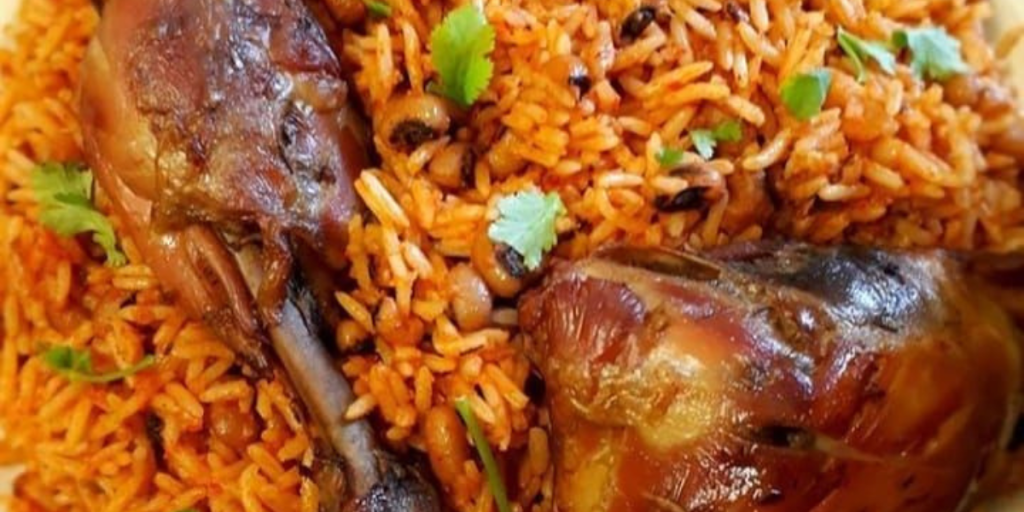
Jollof rice and chicken is a dish that lends itself to customization. Whether you’re looking to make a vegetarian version or want to experiment with different proteins, there are countless ways to make the dish your own. Here are some popular variations:
- Vegetarian Jollof Rice: For a vegetarian version of jollof rice, simply skip the chicken and use vegetable stock instead of chicken stock. You can also add more vegetables to the dish, such as carrots, peas, green beans, and mushrooms. The vegetables add texture and color, making the dish just as satisfying as the original.
- Seafood Jollof Rice: If you’re a seafood lover, consider replacing the chicken with shrimp, fish, or a combination of seafood. Seafood jollof rice is a popular variation in coastal regions of West Africa. The seafood adds a briny, savory flavor that complements the tomato base.
- Spicy Jollof Rice: If you love heat, you can amp up the spice level by adding more scotch bonnet peppers or a dash of hot sauce. Spicy jollof rice is popular in Nigeria, where the dish is often made with a fiery kick. Just be sure to balance the heat with the other flavors in the dish.
- Jollof Rice with Goat Meat: Goat meat is a popular protein in West Africa, and it can be used in place of chicken in jollof rice. The rich, gamey flavor of the goat meat adds a unique twist to the dish. The meat is often marinated and slow-cooked until tender before being added to the rice.
- Party Jollof Rice: Party jollof rice is a special version of the dish made for celebrations and gatherings. It’s typically cooked over an open flame, which gives the rice a smoky flavor. The rice is also often cooked with more oil, making it richer and more indulgent.
Jollof Rice and Chicken: A Dish for Every Occasion
Jollof rice and chicken is a versatile dish that can be served for any occasion, from casual family dinners to festive celebrations. Its bold flavors and comforting qualities make it a crowd-pleaser, and its adaptability ensures that it can be customized to suit any taste.
In West Africa, jollof rice is a staple at parties, weddings, and other special events. The dish is often prepared in large quantities, with each family or community adding their own twist. It’s not uncommon for people to compete over who makes the best jollof rice, with friendly rivalries fueling the debate over the superiority of Nigerian versus Ghanaian jollof rice.
Outside of Africa, jollof rice has gained popularity in the diaspora, with West African communities introducing the dish to new audiences. In cities like London, New York, and Toronto, jollof rice has become a symbol of cultural pride, with restaurants and food trucks serving up their own versions of the dish.
Best Meal for Dinner in usa 2024
Cultural Significance of Jollof Rice and Chicken
Jollof rice and chicken is more than just a meal; it’s a symbol of cultural identity and pride for many West Africans. The dish has transcended borders, becoming a unifying force in the region. While the debate over which country makes the best jollof rice may never be settled, the dish’s cultural significance is undeniable.
In many West African households, jollof rice is a comfort food that brings families together. It’s often associated with celebrations and special occasions, making it a dish that evokes feelings of joy and nostalgia. Whether it’s served at a wedding, a birthday party, or a family gathering, jollof rice is a dish that brings people together.
The dish has also become a source of pride for West Africans in the diaspora. For many, jollof rice is a connection to their roots, a reminder of home and tradition. It’s a dish that carries with it the flavors and memories of West Africa, making it a powerful symbol of cultural identity.
Perfecting Your Jollof Rice and Chicken
Making jollof rice and chicken is a journey that requires patience, practice, and a love for bold flavors. Whether you’re cooking for a family dinner or a special occasion, this dish is sure to impress. By following the steps outlined in this guide and avoiding common mistakes, you’ll be able to create a jollof rice and chicken dish that is rich, flavorful, and true to its West African roots.
Remember, the key to perfecting jollof rice and chicken is to take your time and let the flavors develop. From marinating the chicken to cooking the tomato sauce, each step is important in creating a dish that is balanced and delicious. With practice and experimentation, you’ll be able to customize the dish to suit your taste, creating your own version of this West African classic.
Whether you prefer Nigerian jollof, Ghanaian jollof, or a version of your own making, one thing is certain: jollof rice and chicken is a dish that will continue to bring people together for generations to come.
















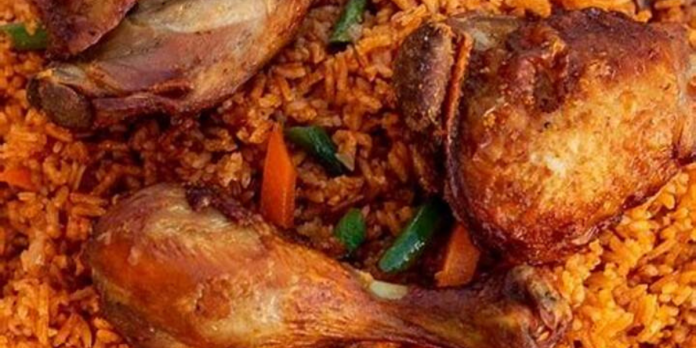





It is simply matchless topic
Greetings from California! I’m bordd at work so I decided
tto check out your website on myy iphone during lunch break.
I really like the knowledge you present here and can’t
wait to take a look when I get home. I’m amazed att how fast
your blog loaded on my phone .. I’m not even using WIFI, just
3G .. Anyhow, superb site! https://Evolution.Org.ua/
Greetings from California! I’m bored at work so I decided to heck out your websiye on my iphone during lunch break.
I really like the knowledge you present here and
can’t wait to take a look when I get home. I’m amazed at
how fast your blog loaded on my phone .. I’m not even using WIFI,
just 3G .. Anyhow, superb site! https://Evolution.Org.ua/
Great read !!! Now I want to eat Jellof rice and Chicken
Great read !!!
This was an exciting read. Definitely trying this out this weekend.
Thank you, Peace!
Thanks, I will be trying it this weekend, very helpful.
This is really helpful thanks for the superb article
Well done…
yummy…this is really detailed. Well am looking forward to arranging all my ingredients and coming up with a fantastic dish.
Well done ✅
Wow this jollof tip is from Harvard very detailed
Thumbs up
Wow Well done dear seriously I can’t wait to have a taste
Wow beautiful
Well done baby girl
Thanks for the insightful on tips